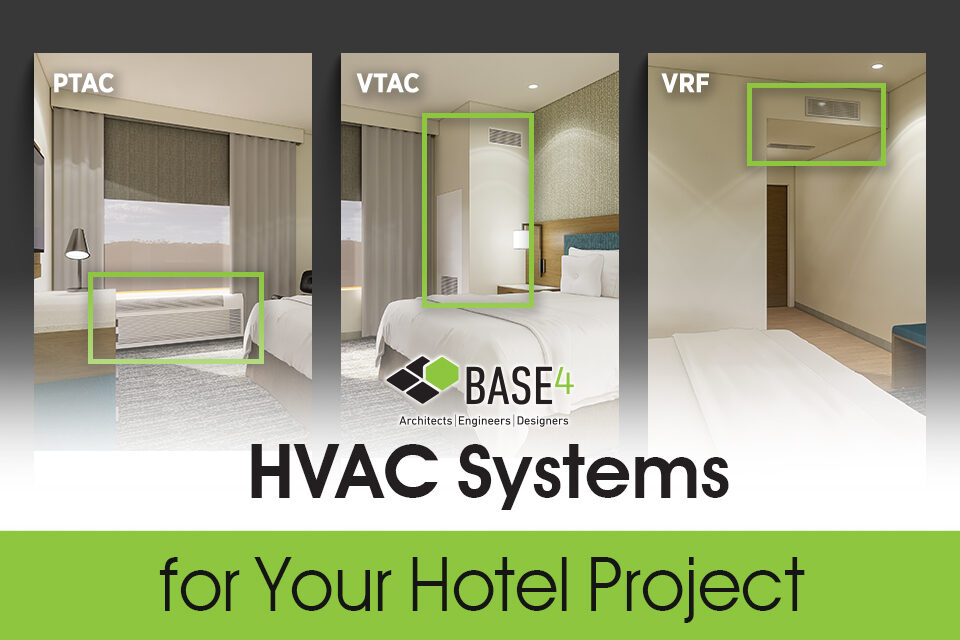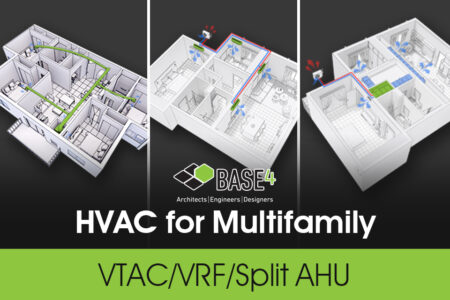HVAC systems for hotels can vary from property to property. If you are building a hotel project, you will typically want to use a system that provides optimal comfort for the hotel guest. HVAC systems are a big part of your hotel project; picking the right one can be challenging. Read on!
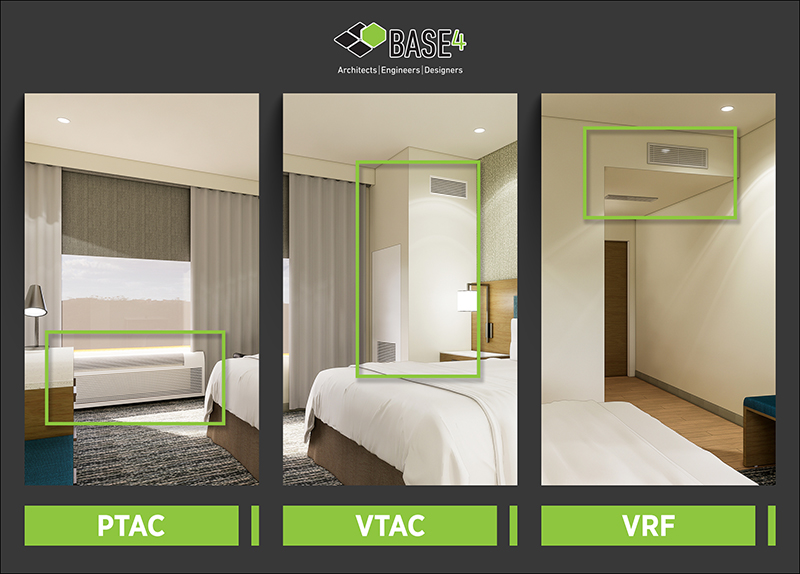
![]() The heating, ventilation, and air cooling (HVAC) system maintains desirable air circulation, humidity, and temperatures in a space.
The heating, ventilation, and air cooling (HVAC) system maintains desirable air circulation, humidity, and temperatures in a space. ![]()
Hotel HVAC Systems
The BASE4 team is often asked about the most appropriate HVAC system for midscale, select service brands. The three primary alternatives that we suggest are:
- Packaged Terminal Air Conditioner (PTAC)
- Vertical Terminal Air Conditioner (VTAC)
- Variable Refrigerant Flow (VRF)
PTAC
PTAC stands for packaged terminal air conditioner. These are single, commercial grade, self-contained, and combination air-conditioner/heat pump units designed to heat and cool individual guestrooms. Units are installed on an exterior wall, typically below a window, and the standard width is 42 inches.
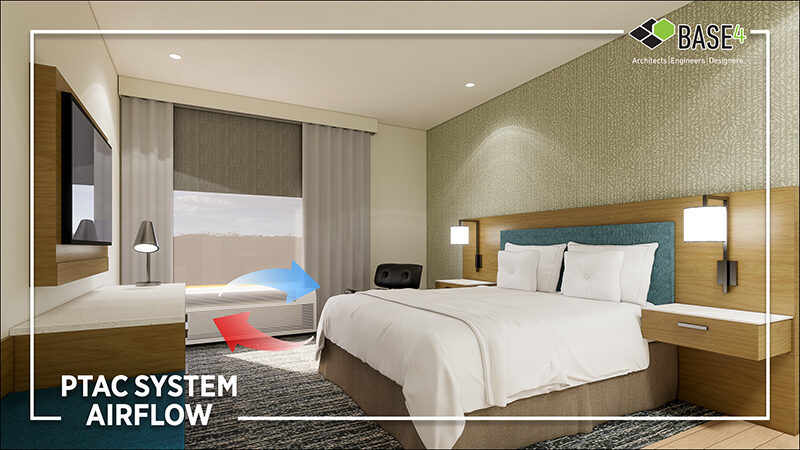
Benefits:
• Easy to install. The PTAC unit is installed in a sleeve that serves as a platform for the outdoor grille and interior unit kit. The sleeve is connected to electrical and condensate lines.
• No outdoor units and refrigerant lines are needed as the units are self-contained.
• PTACs are ideal for single zones.
• No ductwork is required.
• The PTAC is the least expensive HVAC option.
Drawbacks:
• Standard PTAC units cannot provide dehumidified fresh air to an area.
- Note that several manufacturers provide “outside air” PTACs that do offer this feature, but these units cannot pressurize the guestroom.
• Typically, fresh air is provided via a separate DOAS (dedicated outside air system), and an outside/dehumidified air is directly ducted to the guestroom.
• PTAC units can only serve a single room.
• The HVAC condenser is inside the guest room, and the guests can hear this pump turn on and off.
VTAC
VTAC stands for vertical terminal air conditioner. It is a compact through-the-wall packaged system that provides total heating and cooling functions for single or multiple guestrooms.
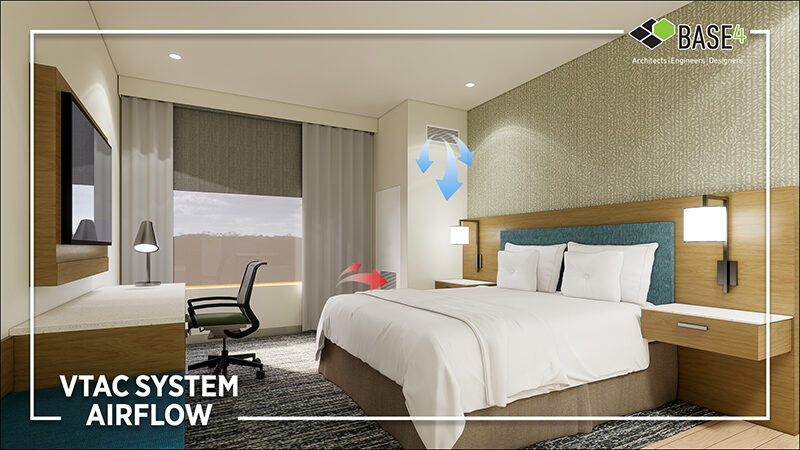
Benefits:
• The terminal is installed in a closet-like corner enclosure with a top-air discharge that is ducted into single or multiple rooms.
• Easy to install. Installation is possible from any interior side (front, right or left) and does not require skilled labor.
• No outdoor units and refrigerant lines. The units are self-contained.
• Easy to maintain and replace the parts as units are installed in the closet.
• VTACs are quieter than PTACs because they are inside an insulated closet, but the condenser is still inside the guest room.
Drawbacks:
• Standard VTAC units cannot provide dehumidified fresh air to a room.
• Typically, fresh air is provided via a separate DOAS (dedicated outside air system), and outside/dehumidified air is directly ducted to the guestroom. A dedicated closet is required, which reduces the overall floor space.
• A Vertical Terminal Air Conditioner is a packaged system that must be installed inside a closet. A dedicated closet is required which reduces the overall floor space.
• Units must be placed with a louver on an exterior wall. This might affect the building’s elevation.
• The HVAC condenser is inside the guest room, and the guests can hear this pump turn on and off.
*Another similar option to VTACs is Variable Refrigerant Packaged (VRP); the two systems share the same benefits, but VRP does not need a DOAS directly ducting to the room. Instead, VRP is a total HVAC solution that utilizes a Precision Inverter compressor, giving it exceptional performance and increased efficiencies of up to 20 SEER and 13.0 EER.
VRF
VRF is a single outdoor condensing unit connected to many indoor units, like fan coil units at entry foyers or bathrooms. VRF units heat and cool different zones thanks to individually controlled refrigerant flow to other evaporators (indoor units).
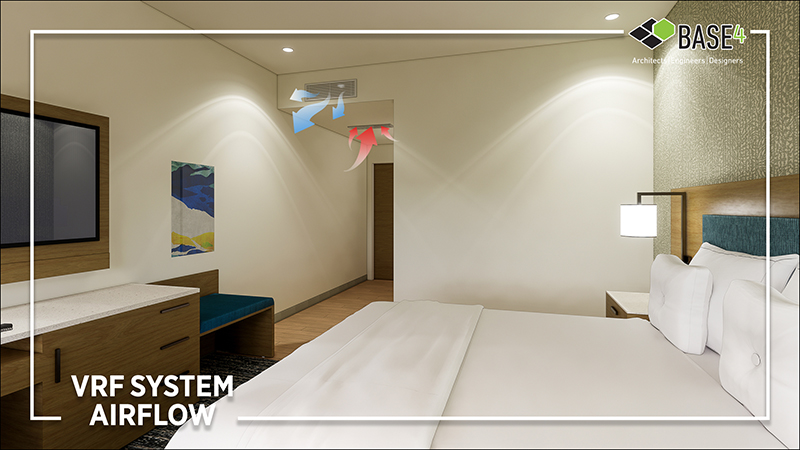
Benefits:
• The multi-split system connects multiple indoor units to one outdoor unit.
• The system saves space and is more aesthetically pleasing to the elevations due to fewer outdoor visible units.
• VRF units simultaneously heat and cool different zones thanks to individually controlled refrigerant flow to different evaporators (indoor units).
• VRF units do not have condensers in the guest rooms, so this is the quietest option.
Drawbacks:
• Fresh air is provided via a separate DOAS (dedicated outside air system), and outside/dehumidified air is directly ducted to the guestroom.
• Typically, the installation cost is higher than other air-conditioning systems.
• A qualified refrigeration mechanic is required for installation.
It’s important to remember that the type of HVAC system you choose for your project will also influence construction cost and energy efficiency. The Seasonal Energy Efficiency Ratio (SEER) for air conditioners and the Annual Fuel Utilization Efficiency (AFUE) ratings on heating systems tell you how efficiently those units use energy. The higher the rating, the less energy gets wasted, and the more of it converts to natural heat or cool air.
Remember that the type of HVAC system you choose for your project will also influence construction cost and energy efficiency.
BASE4 | Your MEP Experts!
Understanding and choosing the best HVAC system for your project can be challenging, so BASE4 is here to help. With decades of experience, our expert team evaluates the unique location and other factors to determine the best HVAC system for your project.


Thank you,
Blair Hildahl
BASE4 Principal
608.304.5228
BlairH@base-4.com
![]()

